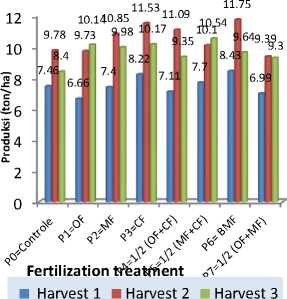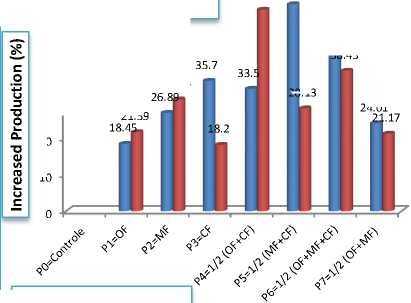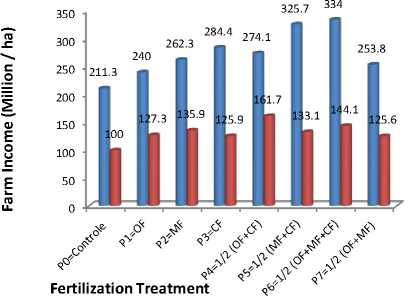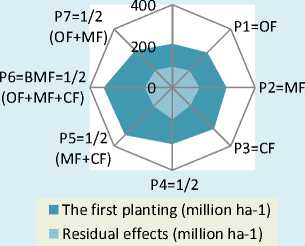THE USE OF BALIPLUS MINERAL FERTILIZER TO INCREASE PRODUCTION AND FARM INCOME OF Phaseolus vulgaris L. (Case Study in Andisol, Baturiti Tabanan Bali)
on
INTERNATIONAL JOURNAL OF BIOSCIENCES AND BIOTECHNOLOGY • Vol. 5 No. 2 • April 2018 ISSN: 2303-3371
https://doi.org/10.24843/IJBB.2018.v05.i02.p08
THE USE OF BALIPLUS MINERAL FERTILIZER TO INCREASE PRODUCTION AND FARM INCOME OF
Phaseolus vulgaris L. (Case Study in Andisol, Baturiti Tabanan Bali)
Indayati Lanya*, and N. Netera Subadiyasa
Agroecotechnology Department, Faculty of Agriculture, Udayana University *Corresponding author: indahnet@yahoo.co.id
ABSTRACT
Increased production of foodstuffs is required in line with increasing population. The tourism sector in Bali needs quality products that are both viable and environmentally friendly. Previous research since 2002-2016, found mineral fertilizer plus can increase the highest production, , increased soil quality, and increased farm income. The research location was in Baturiti Subdistrict. The plant tested was string bean (Phaseolus vulgaris L) during first planting and residual effect of first fertilization (second planting). Eight fertilizer treatments: P0=control, P1=organic, P2= mineral, P3=chemical (NPK), P4=combination ½ (organic+chemical), P5=combination ½ (mineral+chemical), P6= Baliplus mineral fertilizer (BMF) =combination ½ (organic+mineral+chemical), and P7=combination ½(organic+mineral)], three replications. Parameters observed were bean weight, storage capacity, and value of farm income. The experimental designed used was Randomized Block Design, with Duncan's real test difference of 5%, using the Costat program. Fertilization was very influential and significantly affected to the production of the first planting and residual effects. The treatment using BMF in the first crop,resulted in the highest production (34.33 tons ha-1), highest production increase (62.92%), longest storage (36%) for one week, and the highest farm income (Rp 334 million ha-1). The P1 treatment showed the lowest production (25 ton ha-1), the lowest increase (18.45%), storage capacity (15.27%), and the lowest farm income (Rp 28.7 million ha-1). String bean with the highest residual effect (16.17 ton ha-1) was obtained in treatment P4. The average production of the remaining effect is 48.62% of the first crop. The use of mineral fertilizers plus bali can increase production, savings, and farm income, and reduce 50% of the use of chemical and organic fertilizers.
Keywords: Baliplus mineral fertilizer, production, farm income, string bean
INTRODUCTION
Horticultural products such as vegetables, fruits and flowers are required for public consumption, for as component of offering in Hindu religion in Bali as well as for tourism industries. For that purposes, high quality and quantity of horticultural products are required also required the
environmentally friendly production process, so that the products becomehealthy for consumption.. Production and quality of organic fertilizer is allegedly lower than chemical fertilizers, also it is suspected to contain coliform bacteria, because the organic fertilizer was processedfrom animal cages and human waste. However, the
availability of chemical fertilizers also reduced, resulting from the scarcity of fertilizer and lead to the negative impact. Therefore it is needed a fertilizer formula that does not pollute the environment and can increase production, as well as the quality of agricultural products. The research was conducted on sustainable food farms in accordance with previousresearch results (Lanya et al., 2014) especially in the central vegetable production of the highlands.
Research of mineral fertilizer application has been done to increase the production and quality of local fruit, such as oranges, salak, melon (Lanya, 2001), papaya (Subadiyasa et al., 2016), and wetland rice (Proksidatani Tim, 2000) as well as the evaluation of rice fertilization recommendations for specific location on the demonstration plot scale (Lanya, 2002). Research on mineral fertilizers to increase the production and quality of lowland vegetable crops (spinach, green mustard, kale) and marigold flowers was conducted in 2014 (Subadiyasa and Lanya, 2015). In the highlands the mineral fertilizer test was performed on cauliflower, broccoli, marigold flowers, green mustard and carrots. The results showed that baliplus mineral fertilizer, both on the lowland and upland increased the production and quality of fruits, vegetables and marigold flowers. This study examined the role of mineral fertilizer
plus to increase production, quality, food safety and environment for highland horticultural crops. Previous research has shown that mineral fertilizers containing Ca and Mg can increase rice production, lowering the void content (Lanya and Subadiyasa, 2017).
Research on increasing the production of horticultural agriculture is very urgent. The use of organic fertilizer is being vigorously recommended by the central and regional governments. However, from the aspect of production, quality, food safety, and profits, the use of organic fertilizers resulted in lower yields than the use of NPK fertilizer. This is due to the nutrient content required by the very low plant in organic fertilizer, therefore it is needed in large quantities, so it has the potential to damage the environment, mainly COD and BOD, and the colony bacteria it contains. Baliplus mineral fertilizers containing Calcium (Ca) and Magnesium (Mg) in addition to low doses of NPK have been undertaken preliminary studies in several locations in Bali for vegetable crops, and local fruits. The results are able to increase production, product quality and reduce the use of high-dose organic and NPK chemical fertilizers.
Calcium as a cofactor of several enzymes, such as proteinases, contributes to the formation of protein compounds (Stanier et al., 1963 dalam Lanya, 2017).
Furthermore Booth dan Hamilton (1980 , dalam Lanya, 2017), reported that Ca ions act as coupling or energy binders in transporting amino acids with proton drive systems. Mg acts as the core of chlorophyll, the cofactor of several energy-binding enzymes and acid and base stabilizers in the cell. Calcium and magnesium have significance in the symbiotic N air fixation. N fixation by rhizobium takes energy in the form of ATP, Mg as the binding energy from Mg-ATP to Mg-ADP (Rao , 1982, dalam Lanya, 2017). Based on the results of the study, both for food crops, horticulture (vegetables, flowers, and flowers), showed that baliplus mineral fertilizer can increase production, product quality and reduce the use of chemical and organic fertilizers.
MATERIALS AND METHODS
The research was conducted in Bahbahan village, Baturiti, Tabanan, Bali, Indonesia. Baturiti sub-district is the center of horticulture crop production. The improvement of productivity and quality of bean product was done through fertilization test in field with eight fertilizer treatment and residual effect of eight fertilizers, and three replications, namely: (1) = P0 = control, (2) P1 = organic fertilizer (OF = 10 ton ha-1), (3) P2 = mineral fertilizer (MF = dolomite = 5 ton ha-1), (4) P3 = chemical fertilizer (CF = 200 kg ponska + 200 kg
urea) ha-1 = farmer dose , (5) P5 = combination ½ (MF + CF), (7) P6 = combination ½ (OF + MF + CF) = Baliplus mineral fertilizer (BMF) = combination ½ (OF + MF + CF), and (8) P7 = combination ½ (OF + MF), three replications. Size of plot 10 m x1 m = 10 m2, three replicates, plant spacing 50 cm x 50 cm, and spacing between plot 50 cm, and using plastic mulch. Observation parameters were weight, and the production increase, storage capacity, and value of farm income. The observed data or measurement of variance (ANOVA) LSD 0: 5, and the least significant difference (Duncan's Multiple Range Test) using Costat program.
RESULTS AND DISCUSSION
The data of statistical analysis through BNT test are listed in Table 1. The table shows that fertilization is very significant effect on the production of the first planted bean and residual effect of various types of fertilizer.
The graph of the relationship between the eight fertilization treatments with the total first cultivation production and the residual effect of fertilization is shown in Fig. 1. The bean production charts at harvest 1, 2 and 3 are shown in Fig. 2. Graph of the first increase in production of beans and the residual effect of fertilization in Fig. 3. Graph the income of bean farming is presented in Fig. 4.
Table 1.Effect of fertilization on production and increased production of beans.
|
No |
Parameter P |
|
Uji |
Blocks Main effects (replay) Fertilizer |
|
1 |
First bean crop production 0.0262* 0.0000** |
|
2 |
Production of beans of residual effect of fertilizer 0.0010** 0.0000** |
|
3 |
Increased production of the first planting beans (%) 0.0009** 0.000** |
|
4 |
Increased production of beans from the effects of 0.6195 ns 0.0452* residual fertilizer (%) |
LSD 0,05
Notes: * significant; ** highly significant test the smallest real difference (SRD)
|
No |
Fertilization Treatment |
Production (ton ha-1) |
Increased production (%) | ||
|
The first planting |
The residual effect of fertilizer |
The first planting |
The residual effect of fertilizer | ||
|
1 |
P0=Control |
21.13 d |
10.44 d |
Control |
Control |
|
2 |
P1=OF (organic fertilizer) |
25.00 c |
12.73 c |
18.45 c |
21.59 b |
|
3 |
P2=MF (mineral fertilizer) |
26.73 bc |
13.52 bc |
26.69 bc |
23.89 b |
|
4 |
P3=CF (Cemical fertilizer) |
28. 60 b |
12.58 c |
35.75 b |
18.02 b |
|
5 |
P4=1/2 (OF+CF) |
28.09 b |
16.73 a |
33.49 b |
55.08 a |
|
6 |
P5=1/2 (MF+CF) |
33.00 a |
13.32 bc |
56.75 a |
28.13 b |
|
7 |
P6= BMF (Baliplus Mineral Fertilizer) |
34.33 a |
14.41 b |
62.92 a |
38.48 ab |
|
8 |
P7=1/2 (OF+MF) |
26.13 bc |
12.56 c |
24.00 bc |
42.17 ab |
|
Description: The same letters in the same |
column indicate no different | ||||
40
35
30
25
20
Nominal Value
15
10
5
0
P0=Co ntrole
P1=OF
P2=MF
Fertilization treatment
First Production (ton ha-1)
Residual effects (ton ha-1) Long save (%)
21.13
10
25
25
12.73
15.27
26.73
13.59
34.27
P3=CF
28.6
12.59
31.61
|
P4=1/ 2 (OF+C F) |
P5=1/ 2 (MF+C F) |
P6= BMF |
P7=1/ 2 (OF+M F) |
|
28.09 |
33 |
34.33 |
26.13 |
|
16.17 |
13.32 |
14.41 |
12.56 |
|
29.67 |
35.11 |
33.33 |
28.33 |

Fig. 2. Production of beans at harvest 1, 2 and 3.
Fig. 1. Production of String Beans (ton /ha) from Various Fertilization Treatments on First Plan, Residual Effect, and long save (%)
70
62.92
60
50
38.43
40
30.56
30
20
Increased Production (%) for First Research
Increased Production (%) for residual effects
55.2856.75

28.13
24.01
21 59
10
Fertilization Treatment2
Fig. 3. Increased Production of String Beans (%) on Various Fertilization from First Plant and Residual Effect

■ The first planting ( mil ha -1) ■ Residual effects (mil ha-1)
Fig. 4. Farming income of beans (mill ha-1) from organic fertilizer, mineral, NPK and its combination.
Table 1 shows that replication (location) affects the production, on the first planting (P = 0.0262 *). Very significant effect (P = 0.0010 **) on the production of residual effects (P = 0.0010 **) and on increasing production (P = 0.0009 **). But it does not effects the increases of the residual production. Fertilization had a very significant effect on the production of the first planting beans (P = 0.0000 **), production of residual fertilizer effect (P = 0.0000 **), increase of first cultivation production (P = 0000 *) and significant effect on increasing production of residual effect of fertilizer (P = 0.0452 *).
The Difference of the result influenced by the different sites and slope positions, namely on the eastern slope (repeat 3), middle slope (repeat 2), and slopes down in the west (repeat 1). Table 1 and Fig. 1 show that the highest production (28.9 ton ha-1) on
the upper slopes compared to the central slopes (28,035 ton -1), and the lowest slopes in the west (26.7 ton ha-1). This shows that in the sandy Andisol soil there is no nutrient movement at different slope positions. In the first planting of production is affected by the position of the slope and direction of sunlight. While the second planting is influenced by the residue of fertilization. The greater the production in the first plant, the smaller the yield on the second crop. This proves the existence of a relationship between the absorption of nutrients to the production.
The result of BNT test, first crop production data obtained the highest production achieved in the treatment of P6 = BMF (34.33 ton ha-1), and the lowest on the treatment of P1 = OF. Table 1 shows the results of the HORTI-2 varieties study in the potential yield range of ie 25-34 ha-1, is
within the established production range (2437 ton ha-1) by Litbang Pertanian (2015).
The first planting treatment was not different from P6 (BMF) and P5 treatment (33.00 tons ha-1). Similarly, treatment of P3 is not different from P4 and P2 is not different from P8. However, different from treatment of P1 and P2 or P7. Analysis of increased production of beans in the first planting obtained BMF data can increase the highest production (62.92%) and the lowest on the OF (18.45%).
Increased production of beans did not differ between P6 and P5, P3 with P4, P2 with P7. Production is increasingly increasing P1 <P2 / P7 <P3 / P4 <P5 / P6 (Table 1 and Fig. 3). The result of fertilization test at first plant shows that mineral fertilizer can increase production (56% -62%) and reduce ½ of chemical fertilizer (NPK) and ½ organic fertilizer. This is caused by Ca and Mg content contained in balilus mineral fertilizer, besides N, P, and K. Based on the fertilization test the plants require macro nutrients Ca and Mg, in addition to N, P and K. These results are in line with previous research that BMF is able to increase the production and quality of food crops and hortukultura.
The residual effect of fertilization has a very significant effect on the production of beans (Table 1). Table 1 and Fig. 2, the highest production (16.73 ton ha-1) in
treatment P4 (1/2 (OF + CF) and lowest in treatment P1 = OF (12.73 ton ha-1). This shows that the combination of organic and chemical fertilizers are needed to obtain a second plant production in Andisol sandy soil. Similarly, for the production increase, the combination of these two fertilizers reaches 55%. Production of the remaining effect of organic fertilizer that will increase in the next planting is not proven. Because the results of fertilization tests showed both the first planting and the effect of residual organic fertilizer always get the lowest yield, although the dose is 10 tons ha-1. This is due to low nutrient content, compared with chemical fertilizers and mineral fertilizers.
This fertilization test data proves that, both in the first planting and residual effects, organic fertilization obtained the lowest production compared with other fertilizer use. On sandy Andisol soils, organic fertilizers need to be added to hold water. But to get high production and increase it is necessary addition of chemical fertilizers and minerals. It is proven that BMF with the combination formula of organic, chemical and mineral fertilizers get the highest production and the highest increase in production.
Revenue earned on beans on the first plant in line with production and peningkatnnya. The highest income P6 (334 million ha-1) was achieved on BMP
fertilization (Fig. 4). Declining P5 (325.7 million ha-1), P3 (284.4 million ha-1), P4 (274.1 million ha-1), P2 (262.3 million ha-1), P7 (253.8 million ha-1), P1 (240 million ha-1), P0 = (211.3 million ha-1). In contrast to the residual effects of farming, obtained the highest revenue in treatment P4 (161 Million ha-1), the lowest incomes from the use of organic fertilizers (127.3 million ha-1).
Farm income is in line with production, average income of residual effec fertilizer farming system ranges from 40-59% from first planting. A comparison picture of the income of first crop farming and the effectiveness is shown in Fig. 5. The results of this study indicate that fertilization is needed both for the first planting or next planting.The use of BMP fertilizer obtained the highest production and farm income, followed by mineral fertilizer with NPK. In contrast, using organic fertilizer will get the lowest production and farm income. Fertilizers containing N, P, Ca and Mg (BMF) can increase farm production and
income.
P0=Controle

Fig. 5. Farm income of string bean
( Milllion ha-1)
ACKNOWLEDGEMENT
Gratitude to the Minister of Education and Culture of the Republic of Indonesia, the Minister of Agriculture and Minister of Cooperatives of the Republic of Indonesia that has provided research grants. The Rector of Udayana Univeritas and Mr. Dean of the Faculty of Agriculture which provide our research facility we say thank you. As well as to colleagues who helped research we say thank you.
REFERENCES
Lanya, I. (2001). Increased productivity and quality of melon fruit, and agribusiness, through the addition of mineral fertilizers. Agritrop, 20(2), 8690.
Lanya, I. (2002). Evaluation of Rice Fertilization Recommendations for Specific Location Region of Agricultural Extension Center. Bali Province. Agritrop, 21(2), 57-63.
Lanya, I., Subadiyasa, N. N., Sardiana, K., & Ratna Adi, G. P. (2014). Numerical clasification, Subak zoning and land transfer function paddy field in Province of Bali on Remote Sensing and GIS. Procedia Enverimental Sciences, 24, 47-55.
Lanya, I., & Subadiyasa, N. N.. (2017).
Mineral vertilizer as an alternative fertilizer in creasing rice field in Tabanan Regemcy. International Journal Bioscience and Biotechnology Journal of Asia Oceanesia Bioscience and Biotechnology consortium, 2, 99109.
Litbang Pertanian. (2015). Budidaya
tanbaman buncis. Available from: URL: www.hortikultura.litbang.pertanian.go
.id/teknologi-detail-46.html.
Downloaded on August 10 th.
Subadiyasa, N., & Lanya, I. (2015).
Preservation of Subak land resources, increasing productivity and quality of agricultural commodities Bali tourism support. Final report of competency grant research. Faculty of Agriculture, Udayana University. Denpasar.
Subadiyasa, N., & Lanya, I. I.DM.
Artagama. (2016). Increasing
production and quality improvement of papaya fruit trough mineral vertilization. Proceding International Converency on Bioscience and Biotechnology. For Sustaibable Life. 7th ICBB 2016. Faculty of Agricultura Udayana University. Denpasar,14-15 August 2016: hlm. 37-41.
Tim Proksidatani Korwil Bali, 2000. Program pendampingan masyarakat tani menuju ketahanan pangan
nasional (Proksidatani) kordinator wilayah Bali. Laporan akhir. Lembaga Penelitian dan Pengabdian kepada Masyarakat. Universitas Udayana. Denpasar.
ASIA OCEANIA BIOSCIENCE AND BIOTECHNOLOGY • 154
Discussion and feedback